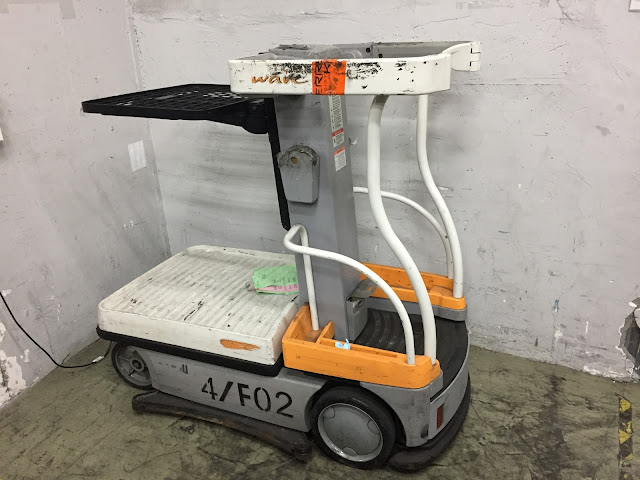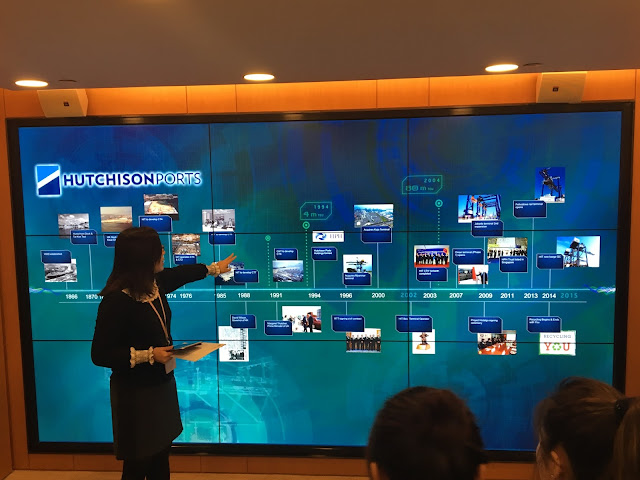Company Background
Kerry Logistics is a company that provide different logistic services. They include third party logistics, international freight forwarding, warehouse operations and supply chain solutions. The headquarter of Kerry Logistics located in Hong Kong. It also operates distribution network and hub in China and Asia region. Over 100 brands from different industries around the world employ Kerry logistics, including fashion & lifestyle, electronics & technology, food & beverage, FMCG, to industrial & material science, automotive, and pharmaceutical & healthcare. They aim to deliver products faster and more cost-effective by applying world-class assets, industry experts and award-winning IT systems and process.
Introduction of Kerry Logistics hub in Hong Kong
The employee explains the background of the distribution centre project. Their project operates in two floors in the building, which are the fourth floor and seven floors. The fourth floor mainly for retail products storing. The eleventh floor mainly for franchise products storing. The distribution centre is operating for three brands. For the retail industry, Kerry mainly serves the local market, but they serve the oversea market for franchises. Products transport to the distribution centre by three logistic models, which are by truck, by sea and by air.
Guide Tour
After we arrived Kerry Logistics Building, we went to a floor that have a hanging garden in the middle of the office. Then we went to visit the warehouse.
This is the inbound area. The first step that they do is sort by purchasing order when the products arrive. After that, they will do the scanning by cartons. Then they will do the inbound audit activities, which included 5 percent quantity check per purchasing order and check the price tag in the garments.
Then, they will do the demix receiving and put-away of products procedures. Demix means that classify the product, such as classify by size. After these procedures, the products would be put on the storage shelves.
Then we go to visit the outbound area. This is the product allocate shelves for each store. If the store log is full, the products would be deliver. There are three types of packing methods, which are piece pick, pick-to-store and full-carton pick. Piece pick means the worker will go the check the quantity needed by the handheld, and then pick the products and put the products to empty cartons. Piece pick productivity is relatively low, which is about 100 piece per hour. Pick-to-store means that the products are pick to meet the quantity required by each store. The productivity for pick-to-store is about 200 to 300 piece per hour. So the productivity is greatly increased by using pick-to-tore.
This electric truck is used to transfer products in the warehouse. No license is need to use the truck.
The cartons are group by divisions, such as men, women and babies. It helps the workers to do the packing because picking is picking by divisions.
Bar code and detail information about each product is shown clearly on the tag.
The hub is serving GAP, Banana Republic and Old Navy.
The screen near the office is showing all inbound and outbound data. It keeps updating every hour so the employees can know whether they meet the daily target.
Question and Answers
Q.How exactly does your “KerrierVISION” IT Platform work to enhance supply chain management?
KerrierVISION is key to monitor the transportation process. When we pick up the goods from center, the 3PL can enter data and updated data in system, until they transport to our warehouse. The client can check the record and data in the KerryVision. It will also transport to the final consumer, so they can also check the record in the system. That’s why it can help them to monitor its process and goods. Thus, the system helps to analysis the data and improve the time management.
Q.How does Kerry take advantage of advanced technologies (such as Internet of Things, wearable technology, etc.) to enhance accessibility and connectivity along the supply chains?
Kerry applied various technologies in supply chain, such as use Voice Picking system in warehouse for order picking and packing procedure. Worker can just use the Android phone and connect with headset and microphone. When it connected to warehouse management system, worker will receive picking command, such as where should they go and which goods they should pack. It can free their hand as they did not need paper and pen. They can pick and pack the goods more comfortably and easily.
Q.Kerry Logistics provides different supply chain solutions to clients from different industries such as fashion, F&B, automotive, etc. How does Kerry Logistics fulfil the wide variety of requirements with limited resources?
Kerry is one of largest company which servicing different kinds of clients, such as food & beverage, electronic plant and fashion lifestyle plant. It will separate their colleague into different segment groups which have expert experience for servicing different industries. They can use their expertise to service their clients more comprehensively as they can understand their clients and fulfill their specified requirements.
Q.How does Kerry Logistics use tracking and tracing system to provide real-time service to customers? Are there any tailored-made systems for specific customers and/or high-end products?
Kerry has Proof of Delivery (POD) system, when Kerry delivery goods to final customers, it will have android phone to recording where are we transporting our goods. When the goods leave warehouse, it will record data manually to update in the system. Then the driver or delivery man will call the final customer and ask them to record the receiving process. So, our customer can track the goods via the system to see the delivery stage.
Q.Apart from adopting environmental friendly designs in office, what other practices do Kerry Logistics has deployed in promoting sustainability?
Kerry use LED lighting for in house operation. Apart from this, Kerry got a certificate for proofing the structure of building with environmental friendly, which means we used LED lighting and use environmental friendly material. In addition, Kerry have some range of water collection facilities inside the warehouse. Also, the trucks they used for delivering goods are preferred to use electronic rather than oil fuel.
Kerry has Return merchandise authorization process (RMA) and some checking for clients. Also, they would fulfil some client’s special request. For example, it was used to help Godiva to pack and unpacking gift set during valentine day and Christmas day and then delivery to their store.
Q.How do Kerry logistics expand new customer base?
Kerry have professional sale team which response to continuously explore business in Hong Kong or overseas. Also, Kerry has integrated logistic part and the international freight forwarding part. So, there are different customer base between IFF part and IL part. So, the sale team would try to use cross selling strategy. For example, they would ask the client from IFF part whether they are interested to use the IL service.
Q.How did Kerry manage to keep its operation smoothly when Kerry had to redesign its warehouse layout to cater the implementation of the robotic butler system in its P3C facility? Is it always the case that automation brings positive impact towards the company?
Kerry has team of PME to plan how to allocate goods and service. They will work with not only PME team but also the warehouse staff. As the warehouse staff have many experience in dealing with the good demand size like the season fluctuation, they have more knowledge to implement the robotic butler system.
While in the planning process, Kerry will develop some emergency plans. Under certain circumstances, it will plan some guideline for the employee to follow. So, it can solve some problems more easily with more detail planning.
Q.What are the competitive advantages of Kerry Logistics in logistics industry?
As Kerry has been established over 30 years, it has many different expertise from years. Kerry has accumulated a lot of knowledge and history. The old staff can help to training the new staff based on their experience; while the new staff would bring new ideas into company. Also, Kerry has sufficient support to employee. It will provide some training for all worker so that they can master new technology.
Also, Kerry can enjoy economic of scale. It can make use of some warehouse and many manpower. When the different client has a different peak season, it can allocate a different resource from the different warehouse and then it can support each other more easily.
Q.How Kerry Logistics adopts green technology in the warehouse operation and transportation?
The answer is same as question 5.


















































